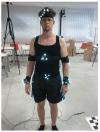Survey of Motion Tracking Methods Based on Inertial Sensors: A Focus on Upper Limb Human Motion
- PMID: 28587178
- PMCID: PMC5492902
- DOI: 10.3390/s17061257
Survey of Motion Tracking Methods Based on Inertial Sensors: A Focus on Upper Limb Human Motion
Abstract
Motion tracking based on commercial inertial measurements units (IMUs) has been widely studied in the latter years as it is a cost-effective enabling technology for those applications in which motion tracking based on optical technologies is unsuitable. This measurement method has a high impact in human performance assessment and human-robot interaction. IMU motion tracking systems are indeed self-contained and wearable, allowing for long-lasting tracking of the user motion in situated environments. After a survey on IMU-based human tracking, five techniques for motion reconstruction were selected and compared to reconstruct a human arm motion. IMU based estimation was matched against motion tracking based on the Vicon marker-based motion tracking system considered as ground truth. Results show that all but one of the selected models perform similarly (about 35 mm average position estimation error).
Keywords: inertial measurements units; kinematics; motion tracking; sensor fusion.
Conflict of interest statement
The authors declare no conflict of interest. The founding sponsors had no role in the design of the study; in the collection, analyses, or interpretation of data; in the writing of the manuscript, and in the decision to publish the results.
Figures








Similar articles
-
Position Tracking During Human Walking Using an Integrated Wearable Sensing System.Sensors (Basel). 2017 Dec 10;17(12):2866. doi: 10.3390/s17122866. Sensors (Basel). 2017. PMID: 29232869 Free PMC article.
-
A Multi-Modal Under-Sensorized Wearable System for Optimal Kinematic and Muscular Tracking of Human Upper Limb Motion.Sensors (Basel). 2023 Apr 3;23(7):3716. doi: 10.3390/s23073716. Sensors (Basel). 2023. PMID: 37050776 Free PMC article.
-
Real-Time Limb Motion Tracking with a Single IMU Sensor for Physical Therapy Exercises.Annu Int Conf IEEE Eng Med Biol Soc. 2021 Nov;2021:7152-7157. doi: 10.1109/EMBC46164.2021.9630480. Annu Int Conf IEEE Eng Med Biol Soc. 2021. PMID: 34892750
-
Indirect Measurement of Ground Reaction Forces and Moments by Means of Wearable Inertial Sensors: A Systematic Review.Sensors (Basel). 2018 Aug 5;18(8):2564. doi: 10.3390/s18082564. Sensors (Basel). 2018. PMID: 30081607 Free PMC article. Review.
-
Inertial Measurement Unit Sensors in Assistive Technologies for Visually Impaired People, a Review.Sensors (Basel). 2021 Jul 13;21(14):4767. doi: 10.3390/s21144767. Sensors (Basel). 2021. PMID: 34300507 Free PMC article. Review.
Cited by
-
Exploring Risk of Falls and Dynamic Unbalance in Cerebellar Ataxia by Inertial Sensor Assessment.Sensors (Basel). 2019 Dec 17;19(24):5571. doi: 10.3390/s19245571. Sensors (Basel). 2019. PMID: 31861099 Free PMC article.
-
Measuring hand movement for suturing skill assessment: A simulation-based study.Surgery. 2023 Nov;174(5):1184-1192. doi: 10.1016/j.surg.2023.07.007. Epub 2023 Aug 17. Surgery. 2023. PMID: 37597999 Free PMC article.
-
A Wearable IMU System for Flexible Teleoperation of a Collaborative Industrial Robot.Sensors (Basel). 2021 Aug 31;21(17):5871. doi: 10.3390/s21175871. Sensors (Basel). 2021. PMID: 34502761 Free PMC article.
-
An Inertial Measurement Unit-Based Wireless System for Shoulder Motion Assessment in Patients with Cervical Spinal Cord Injury: A Validation Pilot Study in a Clinical Setting.Sensors (Basel). 2021 Feb 4;21(4):1057. doi: 10.3390/s21041057. Sensors (Basel). 2021. PMID: 33557140 Free PMC article.
-
A Novel Method and System Implementation for Precise Estimation of Single-Axis Rotational Angles.Sensors (Basel). 2024 Sep 6;24(17):5795. doi: 10.3390/s24175795. Sensors (Basel). 2024. PMID: 39275706 Free PMC article.
References
-
- Fortino G., Giannantonio R., Gravina R., Kuryloski P., Jafari R. Enabling effective programming and flexible anagement of efficient body sensor network applications. IEEE Trans. Hum.-Mach. Syst. 2013;43:115–133. doi: 10.1109/TSMCC.2012.2215852. - DOI
-
- Chen M., Gonzalez S., Vasilakos A., Cao H., Leung V.C. Body area networks: A survey. Mob. Netw. Appl. 2011;16:171–193. doi: 10.1007/s11036-010-0260-8. - DOI
-
- Lefferts E.J., Markley F.L., Shuster M.D. Kalman filtering for spacecraft attitude estimation. J. Guid. Control Dyn. 1982;5:417–429. doi: 10.2514/3.56190. - DOI
-
- Shuster M.D., Oh S.D. Three-axis attitude determination from vector observations. J. Guid. Control Dyn. 1981;4:70–77. doi: 10.2514/3.19717. - DOI
-
- Choi S., Do J., Hwang B., Lee J. Static attitude control for underwater robots using multiple ballast tanks. IEEJ Trans. Electr. Electron. Eng. 2014;9:S49–S55. doi: 10.1002/tee.22032. - DOI
Publication types
MeSH terms
LinkOut - more resources
Full Text Sources
Other Literature Sources

